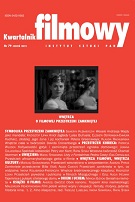"Wesele" Andrzeja Wajdy jako mandala
Andrzej Wajda’s "Wedding" as a mandala
Author(s): Seweryn KuśmierczykSubject(s): Theatre, Dance, Performing Arts
Published by: Instytut Sztuki Polskiej Akademii Nauk
Keywords: Wajda; Andrzej; Jung; C. G.; van Gennep; Arnold; Florensky; Paul; Sobociński; Witold; Wedding; history of film; Polish film; Polish culture; Polish folk culture; mandala.
Summary/Abstract: The author calls on the concept of the mandala by C. G. Jung as ideogram expressing the content of the mental state in the current stage of the development of the inner man. The interpretation of "Wedding" as a mandala presents the location of the action as a quadrilateral inscribed in a circle. The analysis reveals the three sequences comprising the film, the fractal triadic structure of the whole work, the metamorphosis of the characters, and its close relationship with changing time and space and the importance of vision scenes. The author discusses the mythic-initiation structures and the rite of passage structure using the interpretative framework of Arnold van Gennep. He analyzes the unity of the visual and audio layers of the film, interpreted in the light of Paul Florensky’s ideas on golden highlighting in Russian orthodox icons. He discusses the colour scheme of the film, which is judged to be a remarkable achievement by Witold Sobociński cinematography. He shows the symbolic meaning of the colours that refer to color semantics in Polish folk culture and their relationship with the symbolism of the mandala form and the metamorphosis of the characters.
Journal: Kwartalnik Filmowy
- Issue Year: 2012
- Issue No: 79
- Page Range: 6-21
- Page Count: 16
- Language: Polish

